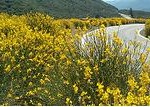 Oregon State University Extension Service: CORVALLIS, Ore. – Although admired for its yellow blooms, the Scotch broom shrub has become an invasive species throughout the Pacific Northwest, where it competes with native plants and forms dense stands that are difficult to manage and remove.Scotch broom was introduced from Europe as a garden ornamental by early settlers of the Pacific Coast.
Oregon State University Extension Service: CORVALLIS, Ore. – Although admired for its yellow blooms, the Scotch broom shrub has become an invasive species throughout the Pacific Northwest, where it competes with native plants and forms dense stands that are difficult to manage and remove.Scotch broom was introduced from Europe as a garden ornamental by early settlers of the Pacific Coast.
Later it was used to prevent erosion and stabilize banks and sand dunes. The woody shrub establishes quickly in disturbed areas, according to Andy Hulting, a weed specialist for the Oregon State University Extension Service.
“Its invasive habit and economic costs have landed Scotch broom on the State Weed Board’s list of noxious weeds, along with its relatives French, Portuguese and Spanish brooms and gorse,” Hulting said. Scotch broom costs Oregonians an estimated $40 million per year in lost timber revenue and control efforts.
What can you do to control this noxious weed? Prevention is the best method, especially in areas where the ground and other plants have been disturbed by overgrazing or development, Hulting said. Care should be taken not to transport soil that is contaminated with Scotch broom seeds.
“Quickly re-vegetate disturbed sites with fast-growing, competitive native plants to limit Scotch broom spread,” he said. “Native trees (such as Douglas-fir or red alder), shrubs (such as woods rose, currants and snowberry) and native grass mixes can help prevent and slow Scotch broom infestations.”
OSU Extension recommends that you learn to identify Scotch broom and the other non-native broom species in the Pacific Northwest that have the potential to become weedy. The publication, Scotch Broom (PNW 103), which has color photos, identification information and control measures, is available online.
If you find Scotch broom on your property, Hulting recommends:
* Dig it up, including the crown.
* Cut it back to the ground each year before it sets seed.
* Keep an eye out for seedlings each spring and pull them up, roots and all, while they are small.
Since Scotch broom seed lasts for years in the soil, vigilance is necessary to prevent reinvasion by new seedlings.
Several broad-spectrum herbicides, including glyphosate and imazapyr, can be effective in controlling Scotch broom infestations. Avoid spraying when plants are blooming; the flowers can prevent thorough coverage to plant tissues.
“Be careful when using herbicides to minimize drift and injury to non-targeted plants,” Hulting warned. If you are unsure about the use of herbicides, contact your county Extension educator.
Remember to wear protective clothing, read the label and follow instructions, and be cautious. You can be liable for injury or damage from herbicide use.
Scientists continue to investigate biological control possibilities for Scotch broom and other noxious weeds. The Oregon Department of Agriculture has released a species of seed weevil whose larvae feed on the developing Scotch broom seedpods. They can destroy up to about 80 percent of the broom seed inside the pods.
You can pop open a mature, brown Scotch broom seedpod to see if seed weevils are working. Look for tiny white larvae. Do not spray plants with seed weevils.
By: Judy Scott
Source: AndY Hulting
Disclaimer: Articles featured on Oregon Report are the creation, responsibility and opinion of the authoring individual or organization which is featured at the top of every article.

